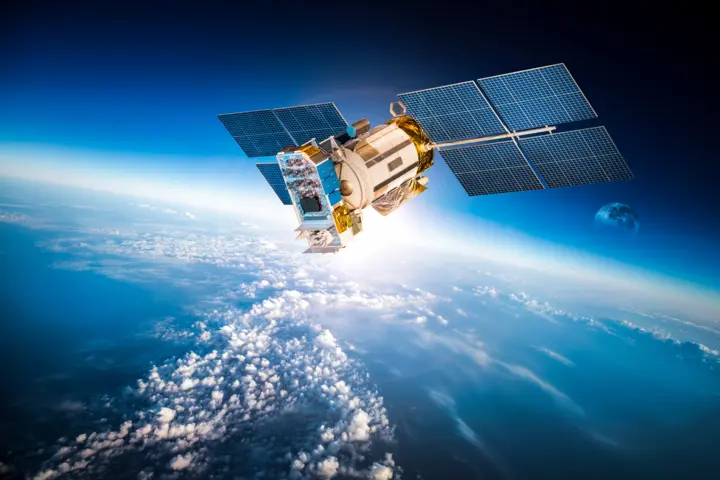Advances in the development of innovative space technologies
In the field of space technology, CSEM has been a partner of the European Space Agency (ESA) for many years. One focus of their joint research ‒ which is also part of ESA's mid-term strategy ‒ is the elimination of vibration emissions originating from components aboard satellites. As well as limiting the precision of attitude control for satellites, these micro-vibrations lead to higher energy consumption and (in case of imaging missions) cause deterioration of image quality.
There are different ways to counter unwanted vibrations either at the source or the payload. As part of its exploration of different approaches, CSEM currently has several projects focusing on numerical models, active-passive mitigation, and algorithm-based notching. In one of these projects, CSEM and its partners are working with an innovative technology based on magnetic levitation. Leopoldo Rossini, who heads the micro-vibration facility at CSEM, reports: “With support from Kistler measurement technology, we examined a reaction wheel prototype with a magnetic bearing. This technology from Celeroton, a Swiss company, offers many advantages such as no friction, a virtually infinite lifetime, the possibility of actively suppressing unwanted vibrations by control, and the opportunity to achieve higher performance at higher speeds.”
Advanced satellite components with low vibrations
The CSEM engineers use a measuring chain from Kistler to examine the vibrations of the reaction wheel prototype. The custom dynamometer comprises four 3-component force sensors sandwich-mounted between two steel plates ‒ a design that achieves maximum mechanical stiffness (see the image). This measuring instrument is mounted on a granite block suspended over four pneumatic isolators so that environmental influences are eliminated as far as possible. Because the micro-vibrations occur in the millinewton range, a highly sensitive measuring chain with very low noise is required. As well as the reaction wheel, various actuators such as a stepper motor and a cryo-cooler can be placed on the instrumentation table to perform the desired measurements.
In the case of the magnetically levitated reaction wheel prototype, the speed range from ‒20,000 to 20,000 rpm was covered: this allowed full characterization of the effectiveness of a multiple-harmonic force rejection algorithm capable of suppressing the main vibrations generated during operation. “The lack of physical contact due to magnetic levitation opens up some very interesting opportunities,” according to Guzmán Borque Gallego, an R&D Engineer at CSEM. “It leaves us almost free to position the rotor in such a way that the vibrations are minimized ‒ for instance, by letting the rotor rotate about its main axis of inertia to suppress any vibration related to the rotor unbalance, which reduces these emissions to near zero.”
"The equipment from Kistler is ideal, and it provided us with results of very high quality."
Guzmán Borque Gallego, R&D Engineer at CSEM
Accurate real-time measurements enable closed-loop control
Borque Gallego continues: “We're measuring rather small forces in the millinewton range ‒ but even in micronewtons, we can still see differences. This allows comfortable judgement of all the measurements, leading to high-quality data in the process.” Data acquisition is handled by a rapid prototyping system at 20 kHz and thanks to the accurate measurements, the effect of the control algorithm can be clearly identified (see the diagrams). Rossini adds: “We received positive feedback about the high quality of the measurements from partners and customers who have extensive experience with this kind of data. None of this would have been possible without support from Kistler: Application Specialist Reinhard Bosshard assisted us in many ways, for example by helping us to choose the right equipment to complete the optimal measuring chain.”
Although the researchers initially intended to use the modern LabAmp 5167A with a digital output, they finally opted for the 5080A charge amplifier from Kistler, which allows even more accurate measurements thanks to its very low-noise input stage. “We're pleased to have new Kistler technology here, because our partners at ESA and in Germany also use it for qualification purposes,” Rossini adds. “This equipment is very robust and did not break down even when stressed beyond the given constraints. Now that it has proven its abilities, we will definitely use it for future projects in the field of vibration characterization ‒ where we already operate accelerometers from Kistler.”
Best possible preparation for the long journey into space
How is the magnetic bearing reaction wheel technology developed by CSEM, Celeroton AG, and their partner in Germany likely to evolve? And will it soon be launched into space? “The advantages of magnetic bearing reaction wheels are obvious: they can generate far lower vibrations and rotate faster than conventional wheels ‒ which means improved performance as well as reduced size and weight. And thanks to the absence of friction, there is no wear and the wheel's lifetime is virtually unlimited,” Borque Gallego emphasizes. “This is a fascinating project, and we hope to move ahead to the next steps: practical use, testing, and maybe even validation together with our partners.”







![Ultimate smoothness [object Object]](https://kistler.cdn.celum.cloud/SAPCommerce_Document_Preview/961-495e.webp)